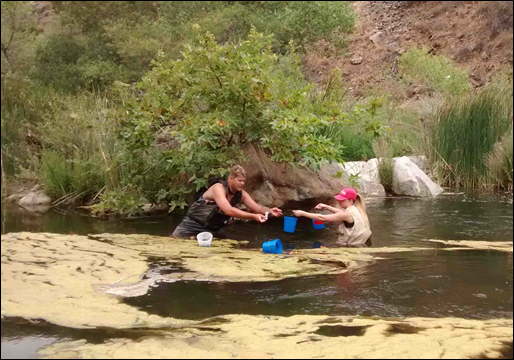Science tools for proposed stream biointegrity-biostimulatory policy released in draft form

The State Water Board has published draft versions of a suite of technical reports, journal manuscripts and tools co-authored by SCCWRP that will serve as the technical foundation for the State in developing a policy that protects the biological integrity of wadeable streams from the impacts of eutrophication and other stressors.
The draft science products, released in October and available for public review online, will support State Water Board staff in crafting a combined biointegrity-biostimulatory policy that includes programs both for assessing stream biointegrity and for limiting excess loading of biostimulatory substances (i.e., nutrients).
SCCWRP and its partners have spent the past three years building the technical backbone for the State Water Board’s anticipated biointegrity-biostimulatory policy. The draft science products were developed in close consultation with various advisory committees and other technical experts.
The State Water Board is planning to spend the next three months soliciting feedback from its advisory groups and the public on the draft products. A draft policy could be released for public comment as early as 2020.
The combined biointegrity-biostimulatory policy is expected to include numeric guidance on how to reduce the biostimulatory impacts of eutrophication and other stressors on wadeable streams. Numeric guidance also will be developed in subsequent phases for lakes, estuaries, enclosed bays and non-wadeable streams.
Separately, California’s Regional Water Quality Control Boards are in various stages of developing comparable regional policies.
The science products developed by SCCWRP and its partners fall into two main categories:
» The biointegrity products explain how quantitative measures of a wadeable stream’s biological condition relate to the stream’s overall ecological health. The State Water Board and other water-quality regulators will consider using this information to establish procedures for sufficiently protecting stream health.
» The biostimulatory products identify a suite of eutrophication indicators (e.g., algal biomass, total nitrogen and phosphorus) for quantifying biostimulatory impacts to wadeable streams. They also summarize the scientific basis for setting numeric targets for these eutrophication indicators that guard against biostimulatory impacts.
The key science products include:
» Algal Stream Condition Index (ASCI): This scoring tool uses algae in streambeds to quantitatively evaluate stream health. The ASCI and the macroinvertebrate-based California Stream Condition Index, which was released in 2015, are expected to serve as the foundation for evaluating the biological integrity of wadeable streams statewide.
» Biological Condition Gradient: This modeling analysis of California streams explains how CSCI and ASCI scores relate to the incremental losses of a stream’s ecological structure and function. Understanding how stream ecological condition degrades along a stressor gradient will help water-quality managers set targets for CSCI and ASCI scores that sufficiently protect the stream’s biological integrity.
» Developed landscapes models: This computer modeling tool predicts the degree to which stream biointegrity scores are likely to be limited, or “constrained,” by urban and agricultural development at a given site. The more constrained a site is, the less likely standard management interventions at the site are to result in improved condition scores. Especially in the South Coast region, where 15% of stream-miles are considered “likely constrained,” managers will benefit from understanding the feasibility of improving CSCI and ASCI scores at a given site.
» Biostimulatory stress-response modeling and synthesis: This series of reports chronicles a proposed empirical modeling approach for translating stream biointegrity targets to numeric biostimulatory targets. The goal is to help managers understand how to set targets for CSCI and ASCI scores that guard against the biostimulatory impacts of eutrophication. Given that about 80% of South Coast stream-miles are predicted to fail to meet the targets necessary to prevent biostimulatory impacts, the modeling work also sets the stage for important discussions related to developing and implementing an appropriate biostimulatory policy.
For more information, contact Dr. Martha Sutula or Dr. Raphael Mazor.
More news related to: Bioassessment, Eutrophication, Harmful Algal Blooms, Indices of Biotic Integrity, Top News